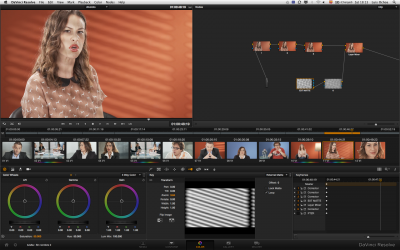News
Advanced DaVinci Resolve Course Rating
On February 23rd took place the advanced DaVinci Resolve course organized by 709 Media Room. It was given by Yoyi Molina, advertising director, special effects technician, colorist, director of photography and technical advisor with experience in multiple productions since the late 90s.
The objective of the course is that in its 8 hours of duration the attendees can learn some advanced techniques of composition and color correction to generate their own looks. For this purpose, various materials will be applied to practical exercises, performed on the DaVinci Resolve 9 Lite system and on Mac Pro(Apple) workstations.
Although this is a hands-on course, and students should already know how to use the system, Yoyi started the day with a brief overview of the color correction tools located in the Color window, which we would be working with for the rest of the day.
After seeing the spheres and bars we arrived at the RGB Mixer, with which we started the first practical application, seeing an example of how to regenerate the signal if I have burned one of the three channels. With this exercise Yoyi took the opportunity to explain the theories of “The seesaw” and then “The time” using the parade and vectorscope.
The next practice consisted of adding a texture to a material and treating it by adjusting its intensity or scaling it. This way we could learn how to use mattes in DaVinci. We also added grain and started to work with secondaries, making it affect only a part of the image, such as the highlights.
Then we moved on to the creation of looks, starting with a simple Bleach Bypass (simulation of a lab process with the same name that you can find in movies like Saving Private Ryan). As these effects involve image compositing, Yoyi explained the use of the Layer Mixer node and some blending modes such as “Overlay” and “Add”.
In the meantime, we learned the technique for black and white diffusions, with which we used the “Screen” and “Overlay” blending modes.
One of the most complex practices brought together several of these elements. The material was an advertising spot and it was a matter of, once analyzed and thinking about what we could bring to that image, creating a certain look (such as “Teal&Orange”) highlighting the main product without the rest of the colors being confused with it. To all this we had to add a white diffusion and add grain, so the resulting node scheme was quite complex and had to be controlled at all times.
One of the important factors of the course is its approach oriented to the understanding that color correction work is not done shot by shot, but by grouping actions. Yoyi organizes the practices in such a way that they can cover Track (applying the correction to the whole track), sequence, groups and individual clips.
In addition, during the course we not only perform exercises that serve to stylize the image, but also teach techniques to improve (or preserve) it. An example of this is how to retouch the actresses’ skins to avoid spots and wrinkles; or how to work with luminance and chrominance separately to avoid artifacts in very compressed formats.
It is not always possible to work with the best formats, nor with as much time as we would like. Therefore, another exercise consisted of creating a style (using the effect from Schindler’s Listbut with two colors), damaging the image as little as possible and with a time limit.
Finally, we saw how to add gobos to an image, how to make an American night without any elements that could reveal us, and how to legalize the values of a correction that was originally made for the Internet and that we want to send to television.
In between these practices there are always new tips and explanations from Yoyi, such as how to match planes in a parade, which tools are more aggressive than others, questions about the inner workings of DaVinci when working with nodes, etc.
All in all, this is a highly recommended course if you already know how DaVinci Resolve works but still want to know more about creating styles and some “tricks” to solve certain problems through color correction.
If you are interested in future calls for this course, here you have all the information available.





